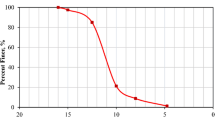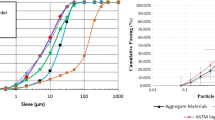Abstract
One of the strategic materials used in earth-fill embankment dams and in modifying and preventing groundwater flow is plastic concrete (PlC). PlC is comprised of aggregates, water, cement, and bentonite. Natural zeolite (NZ) is a relatively abundant mineral resource and in this research, the microstructure, unconfined strength, triaxial behavior, and permeability of PlC made with 0%, 10%, 15%, 20%, and 25% replacement of cement by NZ were studied. Specimens of PIC-NZ were subjected to confined conditions and three different confining pressures of 200, 350, and 500 kPa were used to investigate their mechanical behavior and permeability. To study the effect of sulfate ions on the properties of PlC-NZ specimens, the specimens were cured in one of two different environments: normal condition and in the presence of sulfate ions. Results showed that increasing the zeolite content decreases the unconfined strength, elastic modulus, and peak strength of PlC-NZ specimens at the early ages of curing. However, at the later ages, increasing the zeolite content increases unconfined strength as well as the peak strength and elastic modulus. Specimens cured in the presence of sulfate ions indicated lower permeability, higher unconfined strength, elastic modulus, and peak strength due to having lower porosity.
Similar content being viewed by others
References
Alós Shepherd D, Kotan E, Dehn F. Plastic concrete for cut-off walls: A review. Construction & Building Materials, 2020, 255: 119248
Song S, You P. Performance of plastic concrete under true tri-axial compressive stress. Construction & Building Materials, 2021, 266: 121106
Ghanizadeh A R, Abbaslou H, Amlashi A T, Alidoust P. Modeling of bentonite/sepiolite plastic concrete compressive strength using artificial neural network and support vector machine. Frontiers of Structural and Civil Engineering, 2019, 13(1): 215–239
Amlashi A T, Abdollahi S M, Goodarzi S, Ghanizadeh A R. Soft computing based formulations for slump, compressive strength, and elastic modulus of bentonite plastic concrete. Journal of Cleaner Production, 2019, 230: 1197–1216
Juenger M C G, Siddique R. Recent advances in understanding the role of supplementary cementitious materials in concrete. Cement and Concrete Research, 2015, 78: 71–80
Wen L, Chai J, Xu Z, Qin Y, Li Y. Comparative and numerical analyses of response of concrete cutoff walls of earthen dams on alluvium foundations. Journal of Geotechnical and Geoenvironmental Engineering, 2019, 145(10): 04019069
ICOLD. Filling Materials for Watertight Cut off Walls. Paris: International Committee of Large Dams, 1985
Feng N Q, Li G Z, Zang X W. High-strength and flowing concrete with a zeolitic mineral admixture. Cement, Concrete and Aggregates, 1990, 12(2): 61–69
Soroush A, Soroush M. Parameters affecting the thickness of bentonite cake in cutoff wall construction: Case study and physical modeling. Canadian Geotechnical Journal, 2005, 42(2): 646–654
Bagheri A R, Alibabaie M, Babaie M. Reduction in the permeability of plastic concrete for cut-off walls through utilization of silica fume. Construction & Building Materials, 2008, 22(6): 1247–1252
Jalal M, Fathi M, Farzad M. Effects of fly ash and TiO2 nanoparticles on rheological, mechanical, microstructural and thermal properties of high strength self compacting concrete. Mechanics of Materials, 2013, 61: 11–27
Damtoft J S, Lukasik J, Herfort D, Sorrentino D, Gartner E M. Sustainable development and climate change initiatives. Cement and Concrete Research, 2008, 38(2): 115–127
Metha P K, Monteiro P J M. Concrete-Microstructure, Properties and Materials. McGraw-Hill Professional, 2001, 23913
Celik K. Development and characterization of sustainable self-consolidating concrete containing high volume of limestone powder and natural or calcined pozzolanic materials. Dissertation for the Doctoral Degree. Berkeley: University of California, Berkeley, 2015
Ochoa L, Hendrickson C, Asce M, Matthews H S. Economic input-output life-cycle assessment of US residential buildings. Journal of infrastructure systems, 2002, 8(4): 132–138
Augustine C, Byrne A, Gimon E, Goerner T, Hoffman I, Kammen D M, Kantner J, Levin J, Lipman T, Mileva A, Muren R, Paul S, Sapatari S, Thorsteinsson H, Tominks C. Redefining what’s possible for clean energy by 2020. Gigaton Throwdown, San Francisco, 2009
USGS MCS. Cement Statistics and Information. Washington, DC: US Geological Survey, 2012
Van Oss H. Minerals Yearbook: Slag-Iron and Steel. Washington, DC: US Geological Survey, 2011
Mehta P K. Sustainable cements and concrete for the climate change era—A review. In: 2nd International Conference on Sustainable Construction Materials and Technologies. Aneona: American Society of Civil Engineers, 2010
Ören A H, Kaya A, Kayalar A Ş. Hydraulic conductivity of zeolite-bentonite mixtures in comparison with sand-bentonite mixtures. Canadian Geotechnical Journal, 2011, 48(9): 1343–1353
Giosuè C, Mobili A, Yu Q L, Brouwers H J H, Ruello M L, Tittarelli F. Properties of multifunctional lightweight mortars containing zeolite and natural fibers. Journal of Sustainable Cement-Based Materials, 2019, 8(4): 214–227
Janotka I, Krajči L. Sulphate resistance and passivation ability of the mortar made from pozzolan cement with zeolite. Journal of Thermal Analysis and Calorimetry, 2008, 94(1): 7–14
Şahmaran M. The effect of replacement rate and fineness of natural zeolite on the rheological properties of cement-based grouts. Canadian Journal of Civil Engineering, 2008, 35(8): 796–806
Vieira G L, Schiavon J Z, Borges P M, da Silva S R, de Oliveira Andrade J J. Influence of recycled aggregate replacement and fly ash content in performance of pervious concrete mixtures. Journal of Cleaner Production, 2020, 271: 122665
Öncü Ş, Bilsel H. Effect of zeolite utilization on volume change and strength properties of expansive soil as landfill barrier. Canadian Geotechnical Journal, 2017, 54(9): 1320–1330
Li F, Zhou C, Yang P, Wang B, Hu J, Wei J, Yu Q. Direct synthesis of carbon nanotubes on fly ash particles to produce carbon nanotubes/fly ash composites. Frontiers of Structural and Civil Engineering, 2019, 13(6): 1405–1414
Sun D, Shi H, Wu K, Miramini S, Li B, Zhang L. Influence of aggregate surface treatment on corrosion resistance of cement composite under chloride attack. Construction & Building Materials, 2020, 248: 118636
Neville A. The confused world of sulfate attack on concrete. Cement and Concrete Research, 2004, 34(8): 1275–1296
ACI Committee 201. Guide to Durable Concrete. American Concrete Institute, 2001
Haufe J, Vollpracht A. Tensile strength of concrete exposed to sulfate attack. Cement and Concrete Research, 2019, 116: 81–88
Chen J, Bharata R, Yin T, Wang Q, Wang H, Zhang T. Assessment of sulfate attack and freeze-thaw cycle damage of cement-based materials by a nonlinear acoustic technique. Materials and Structures, 2017, 50(2): 105
Rasheeduzzafar, Al-Amoudi O S B, Abduljauwad S N, Maslehuddin M. Magnesium-sodium sulfate attack in plain and blended cements. Journal of Materials in Civil Engineering, 1994, 6(2): 201–222
Barger G S, Bayles J, Blair B, Brown D, Chen H, Conway T, Hawkins P. Ettringite formation and the performance of concrete. Portland Cement Association, 2001: 1–16
ASTM. Standard Specification for Portland Cement, ASTM C150. West Conshohocken, PA: ASTM, 2012
ASTM. Standard Test Method for Measuring the Exchange Complex and Cation Exchange Capacity of Inorganic Fine-Grained Soils 1, ASTM D7503-18. West Conshohocken, PA: ASTM, 2020
ASTM. Standard Test Method for Unconsolidated-Undrained Triaxial Compression Test on Cohesive Soils, ASTM D2850-3a. West Conshohocken, PA: ASTM, 2013
ASTM. Standard Test Method for Unconfined Compressive Strength of Cohesive Soil, ASTM D2166. West Conshohocken, PA: ASTM, 2006
Mahboubi A, Ajorloo A. Experimental study of the mechanical behavior of plastic concrete in triaxial compression. Cement and Concrete Research, 2005, 35(2): 412–419
Xu S, Shan J, Zhang L, Zhou L, Gao G, Hu S, Wang P. Dynamic compression behaviors of concrete under true triaxial confinement: An experimental technique. Mechanics of Materials, 2020, 140: 103220
Piotrowska E, Malecot Y, Ke Y. Experimental investigation of the effect of coarse aggregate shape and composition on concrete triaxial behavior. Mechanics of Materials, 2014, 79: 45–57
Fu Z, Su H, Wen Z. Multi-scale numerical analysis for linear elastic behavior of clay concrete. International Journal of Solids and Structures, 2020, 203: 23–45
Hinchberger S, Weck J, Newson T. Mechanical and hydraulic characterization of plastic concrete for seepage cut-off walls. Canadian Geotechnical Journal, 2010, 47(4): 461–471
Sun D, Wu K, Shi H, Miramini S, Zhang L. Deformation behaviour of concrete materials under the sulfate attack. Construction & Building Materials, 2019, 210: 232–241
Sun D, Wu K, Shi H, Zhang L, Zhang L. Effect of interfacial transition zone on the transport of sulfate ions in concrete. Construction & Building Materials, 2018, 192: 28–37
Metha P K, Monteiro P J M. Concrete: Microstructure, Properties, and Materials. 2nd ed. Hoboken, NJ: Prentice Hall, 1993
Badogiannis E, Kakali G, Dimopoulou G, Chaniotakis E, Tsivilis S. Metakaolin as a main cement constituent. Exploitation of poor Greek kaolins. Cement and Concrete Composites, 2005, 27(2): 197–203
Perraki T, Kontori E, Tsivilis S, Kakali G. The effect of zeolite on the properties and hydration of blended cements. Cement and Concrete Composites, 2010, 32(2): 128–133
Perraki T, Kakali G, Kontori E. Characterization and pozzolanic activity of thermally treated zeolite. Journal of Thermal Analysis and Calorimetry, 2005, 82(1): 109–113
Demir F, Armagan Korkmaz K. Prediction of lower and upper bounds of elastic modulus of high strength concrete. Construction & Building Materials, 2008, 22(7): 1385–1393
Liu X, Feng P, Li W, Geng G, Huang J, Gao Y, Mu S, Hong J. Effects of pH on the nano/micro structure of calcium silicate hydrate (C-S-H) under sulfate attack. Cement and Concrete Research, 2021, 140: 106306
Wang S, Wen Y, Fei K. Effects of pH and EC on the strength and permeability of plastic concrete cutoff walls. Environmental Science and Pollution Research International, 2021, 28(31): 42798–42806
Author information
Authors and Affiliations
Corresponding author
Rights and permissions
About this article
Cite this article
Akbarpour, A., Mahdikhani, M. & Moayed, R.Z. Effects of natural zeolite and sulfate ions on the mechanical properties and microstructure of plastic concrete. Front. Struct. Civ. Eng. 16, 86–98 (2022). https://doi.org/10.1007/s11709-021-0793-x
Received:
Accepted:
Published:
Issue Date:
DOI: https://doi.org/10.1007/s11709-021-0793-x




